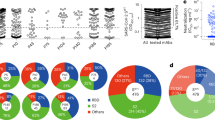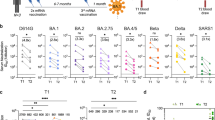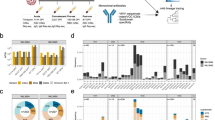Abstract
Few type-specific antibodies that recognize drifted epitopes are made during post-vaccination exposures to SARS-CoV-2 variants1,2,3,4,5,6,7,8,9,10,11,12, perhaps due to suppression by previous immunity. We compared type-specific B cell responses in unvaccinated and vaccinated individuals with Delta and Omicron BA.1 SARS-CoV-2 variant infections. For both Delta, which is antigenically similar to the vaccine strain, and the more distant BA.1 variant, neutralizing antibodies were greater in post-vaccination variant infections than in primary variant infections. Delta type-specific memory B cells were reduced in post-vaccination Delta infections relative to primary variant infections. Yet some drifted epitopes in the Delta variant elicited minimal responses even in primary infections. For BA.1 infections, type-specific antibodies and memory B cells were mostly undetectable, irrespective of previous immunity. Thus, poor intrinsic antigenicity of drifted epitopes in Delta and BA.1 infections superseded the impact of previous immunity. Enhancing the immunogenicity of vaccine antigens may promote type-specific responses.
This is a preview of subscription content, access via your institution
Access options
Access Nature and 54 other Nature Portfolio journals
Get Nature+, our best-value online-access subscription
$32.99 / 30 days
cancel any time
Subscribe to this journal
Receive 12 print issues and online access
$259.00 per year
only $21.58 per issue
Buy this article
- Purchase on SpringerLink
- Instant access to full article PDF
Prices may be subject to local taxes which are calculated during checkout




Similar content being viewed by others
Data availability
Virus sequences are available on GISAID (accession number EPI_ISL_17886211).
References
Amanat, F. et al. SARS-CoV-2 mRNA vaccination induces functionally diverse antibodies to NTD, RBD and S2. Cell https://doi.org/10.1016/j.cell.2021.06.005 (2021).
Sokal, A. et al. Maturation and persistence of the anti-SARS-CoV-2 memory B cell response. Cell 184, 1201–1213.e14 (2021).
Alsoussi, W. B. et al. SARS-CoV-2 Omicron boosting induces de novo B cell response in humans. Nature 617, 592–598 (2023).
Agudelo, M. et al. Plasma and memory antibody responses to Gamma SARS-CoV-2 provide limited cross-protection to other variants. J. Exp. Med. 219, e20220367 (2022).
Evans, J. P. et al. Neutralization of SARS-CoV-2 Omicron sub-lineages BA.1, BA.1.1, and BA.2. Cell Host Microbe 30, 1093–1102.e3 (2022).
Quandt, J. et al. Omicron BA.1 breakthrough infection drives cross-variant neutralization and memory B cell formation against conserved epitopes. Sci. Immunol. 7, eabq2427 (2022).
Kaku, C. I. et al. Recall of preexisting cross-reactive B cell memory after Omicron BA.1 breakthrough infection. Sci. Immunol. 7, eabq3511 (2022).
Park, Y.-J. et al. Imprinted antibody responses against SARS-CoV-2 Omicron sublineages. Science 378, 619–627 (2022).
Röltgen, K. et al. Immune imprinting, breadth of variant recognition, and germinal center response in human SARS-CoV-2 infection and vaccination. Cell 185, 1025–1040.e14 (2022).
Tortorici, M. A. et al. Persistent immune imprinting occurs after vaccination with the COVID-19 XBB.1.5 mRNA booster in humans. Immunity 57, 904–911.e4 (2024).
Liang, C.-Y. et al. Imprinting of serum neutralizing antibodies by Wuhan-1 mRNA vaccines. Nature 630, 950–960 (2024).
Anderson, E. M. et al. SARS-CoV-2 infections elicit higher levels of original antigenic sin antibodies compared with SARS-CoV-2 mRNA vaccinations. Cell Rep. 41, 111496 (2022).
Francis, T. On the doctrine of original antigenic sin. Proc. Am. Philos. Soc. 104, 572–578 (1960).
Cobey, S. Vaccination against rapidly evolving pathogens and the entanglements of memory. Nat. Immunol. 25, 2015–2023 (2024).
Koutsakos, M. & Ellebedy, A. H. Immunological imprinting: understanding COVID-19. Immunity 56, 909–913 (2023).
Zhang, Z. et al. Humoral and cellular immune memory to four COVID-19 vaccines. Cell 185, 2434–2451.e17 (2022).
Goel, R. R. et al. Distinct antibody and memory B cell responses in SARS-CoV-2 naïve and recovered individuals following mRNA vaccination. Sci. Immunol. 6, eabi6950 (2021).
Ripperger, T. J. et al. Orthogonal SARS-CoV-2 serological assays enable surveillance of low-prevalence communities and reveal durable humoral immunity. Immunity 53, 925–933.e4 (2020).
Piccoli, L. et al. Mapping neutralizing and immunodominant sites on the SARS-CoV-2 spike receptor-binding domain by structure-guided high-resolution serology. Cell 183, 1024–1042.e21 (2020).
Starr, T. N. et al. Deep mutational scanning of SARS-CoV-2 receptor binding domain reveals constraints on folding and ACE2 binding. Cell 182, 1295–1310.e20 (2020).
Motozono, C. et al. SARS-CoV-2 spike L452R variant evades cellular immunity and increases infectivity. Cell Host Microbe https://doi.org/10.1016/j.chom.2021.06.006 (2021).
Greaney, A. J. et al. Comprehensive mapping of mutations in the SARS-CoV-2 receptor-binding domain that affect recognition by polyclonal human plasma antibodies. Cell Host Microbe 29, 463–476.e6 (2021).
He, P. et al. SARS-CoV-2 Delta and Omicron variants evade population antibody response by mutations in a single spike epitope. Nat. Microbiol. https://doi.org/10.1038/s41564-022-01235-4 (2022).
Tchesnokova, V. et al. Acquisition of the L452R mutation in the ACE2-binding interface of spike protein triggers recent massive expansion of SARS-CoV-2 variants. J. Clin. Microbiol. 59, e0092121 (2021).
Greaney, A. J. et al. A SARS-CoV-2 variant elicits an antibody response with a shifted immunodominance hierarchy. PLoS Pathog. 18, e1010248 (2021).
McCallum, M. et al. N-terminal domain antigenic mapping reveals a site of vulnerability for SARS-CoV-2. Cell 184, 2332–2347.e16 (2021).
Cerutti, G. et al. Potent SARS-CoV-2 neutralizing antibodies directed against spike N-terminal domain target a single supersite. Cell Host Microbe 29, 819–833.e7 (2021).
Suryadevara, N. et al. Neutralizing and protective human monoclonal antibodies recognizing the N-terminal domain of the SARS-CoV-2 spike protein. Cell 184, 2316–2331.e15 (2021).
Shroff, R. T. et al. Immune responses to two and three doses of the BNT162b2 mRNA vaccine in adults with solid tumors. Nat. Med. 27, 2002–2011 (2021).
Chen, Y. et al. Broadly neutralizing antibodies to SARS-CoV-2 and other human coronaviruses. Nat. Rev. Immunol. 23, 189–199 (2023).
Hicks, J. et al. Serologic cross-reactivity of SARS-CoV-2 with endemic and seasonal betacoronaviruses. J. Clin. Immunol. 41, 906–913 (2021).
Schiepers, A. et al. Molecular fate-mapping of serum antibody responses to repeat immunization. Nature https://doi.org/10.1038/s41586-023-05715-3 (2023).
Cohen, A. A. et al. Mosaic sarbecovirus nanoparticles elicit cross-reactive responses in pre-vaccinated animals. Cell 187, 5554–5571.e19 (2024).
Lutrick, K. et al. COVID-19 infection, reinfection, and vaccine effectiveness in a prospective cohort of Arizona frontline/essential workers: the AZ HEROES research protocol. JMIR Res. Protoc. 10, e28925 (2021).
Horwitz, L. I. et al. Researching COVID to Enhance Recovery (RECOVER) adult study protocol: rationale, objectives, and design. PLoS ONE 18, e0286297 (2023).
Laffeber, C., de Koning, K., Kanaar, R. & Lebbink, J. H. G. Experimental evidence for enhanced receptor binding by rapidly spreading SARS-CoV-2 variants. J. Mol. Biol. 433, 167058 (2021).
DeGrace, M. M. et al. Defining the risk of SARS-CoV-2 variants on immune protection. Nature 605, 640–652 (2022).
Pušnik, J. et al. Vaccination impairs de novo immune response to omicron breakthrough infection, a precondition for the original antigenic sin. Nat. Commun. 15, 3102 (2024).
He, X. et al. The receptor binding domain of SARS-CoV-2 Omicron subvariants targets Siglec-9 to decrease its immunogenicity by preventing macrophage phagocytosis. Nat. Immunol. 25, 622–632 (2024).
Gonzalez-Reiche, A. S. et al. Sequential intrahost evolution and onward transmission of SARS-CoV-2 variants. Nat. Commun. 14, 3235 (2023).
Yisimayi, A. et al. Repeated Omicron exposures override ancestral SARS-CoV-2 immune imprinting. Nature 625, 148–156 (2024).
Hauser, B. M. et al. Rationally designed immunogens enable immune focusing following SARS-CoV-2 spike imprinting. Cell Rep. 38, 110561 (2022).
Dvorscek, A. R. et al. Conversion of vaccines from low to high immunogenicity by antibodies with epitope complementarity. Immunity https://doi.org/10.1016/j.immuni.2024.08.017 (2024).
Amitai, A. et al. Defining and manipulating B cell immunodominance hierarchies to elicit broadly neutralizing antibody responses against influenza virus. Cell Syst. 11, 573–588.e9 (2020).
Ellebedy, A. H. et al. Adjuvanted H5N1 influenza vaccine enhances both cross-reactive memory B cell and strain-specific naive B cell responses in humans. Proc. Natl Acad. Sci. USA 117, 17957–17964 (2020).
Edwards, L. J. et al. Research on the epidemiology of SARS-CoV-2 in essential response personnel (RECOVER): protocol for a multisite longitudinal cohort study. JMIR Res. Protoc. 10, e31574 (2021).
Goldfarb, D. M. et al. Self-collected saline gargle samples as an alternative to healthcare worker collected nasopharyngeal swabs for COVID-19 diagnosis in outpatients. J. Clin. Microbiol. https://doi.org/10.1101/2020.09.13.20188334 (2020).
Rambaut, A. et al. A dynamic nomenclature proposal for SARS-CoV-2 lineages to assist genomic epidemiology. Nat. Microbiol. 5, 1403–1407 (2020).
Acknowledgements
This work was supported by National Institutes of Health grant numbers R01AI099108 and R01AI129945 (D.B.) and R01 AI157155 (M.S.D.) and a research grant from the Arizona Board of Regents (M.W. and D.B.) This project has been funded in part with Federal funds from the National Institute of Allergy and Infectious Diseases, National Institutes of Health, Department of Health and Human Services, under contract number 75N93021C00015 (M.W.) and under contract number 75N93019C00051 (A.G. and R.V.) The HEROES-RECOVER cohort is supported by the National Center for Immunization and Respiratory Diseases and the CDC (contract numbers 75D30120R68013 to Marshfield Clinic Research Institute, 75D30120C08379 to the University of Arizona and 75D30120C08150 to Abt Associates). Disclosures: the findings and conclusions in this report are those of the authors and do not necessarily represent the official position of the CDC.
Author information
Authors and Affiliations
Contributions
G.E.Q., M.W. and D.B. conceived the study, G.E.Q., M.V.S., K.L.P., J.L.U., B.L. and C.-Y.L. designed and performed experiments, G.E.Q., M.V.S., C.-Y.L., M.S.D., B.J.L., J.Z.N., R.S., M.W. and D.B. analyzed data and wrote the paper. J.L.B., K.E., S.B., J.R., K.L., A.F., A.B., H.L.T., A.J.C.-M., A.N., M.G., S.Y., L.J.E., L.O., M.D., R.V., A.G., B.J.L. and D.B. designed human studies and recruitment. G.E.Q., B.J.L., R.S. and D.B. performed the data analyses. D.B. and M.W. directed the study and wrote the paper with G.E.Q.
Corresponding author
Ethics declarations
Competing interests
Sana Biotechnology has licensed intellectual property of D.B. and Washington University in St. Louis. Jasper Therapeutics and Inograft Therapeutics have licensed intellectual property of D.B. and Stanford University. D.B. served on an advisory panel for GlaxoSmithKline on COVID-19 therapeutic antibodies. D.B. serves on the scientific advisory board for Hillevax. D.B. is a scientific cofounder of Aleutian Therapeutics. B.J.L. has a financial interest in Cofactor Genomics, Inc. and Iron Horse Dx. Geneticure Inc. has licensed intellectual property of R.S. and R.S. is a cofounder of Geneticure Inc. M.W. has received consulting fees from Gerson Lehrman Group regarding SARS-CoV-2 and the COVID-19 pandemic. M.S.D. is a consultant or advisor for Inbios, Vir Biotechnology, IntegerBio, Moderna, Merck and GlaxoSmithKline. The Diamond laboratory has received unrelated funding support in sponsored research agreements from Vir Biotechnology, Emergent BioSolutions and IntegerBio. The other authors declare no competing interests.
Peer review
Peer review information
Nature Immunology thanks the anonymous reviewers for their contribution to the peer review of this work. Peer reviewer reports are available. Primary Handling Editor: Ioana Staicu, in collaboration with the Nature Immunology team.
Additional information
Publisher’s note Springer Nature remains neutral with regard to jurisdictional claims in published maps and institutional affiliations.
Extended data
Extended Data Fig. 1 Post-vaccination delta and BA.1 infections report symptoms lasting for a shorter duration compared to primary delta infections.
a. Bar plot showing percentage of individuals from each TATS cohort (primary Delta infection (n = 12), post-vaccination Delta infection (n = 37), and post-vaccination BA.1 infection (n = 50)) that reported experiencing respiratory symptoms in study entry survey. b. Dot plot showing reported days until symptoms resolved for each TATS cohort (primary Delta infection (n = 12), post-vaccination Delta infection (n = 37), and post-vaccination BA.1 infection (n = 50)). Each symbol represents an individual. Medians ± 95% CI are shown. Two-sided P values from t-test statistics were calculated for pairwise differences using one-way ANOVA. Post hoc Tukey’s multiple comparisons test was applied. P values greater than 0.05 are not depicted. c. Correlation of time since vaccination with PRNT90 values against WuHu1 (left), antibody titers against WuHu1 RBD (middle), and the ratio of WuHu1:Delta RBD binding antibodies in vaccinated only (n = 62) cohort. Each symbol represents an individual. Medians ± 95% CI are shown. Two-sided Pearson correlation analysis was performed (left (p = 0.72), middle (p = 0.22), right (p = 0.21)).
Extended Data Fig. 2 Flow cytometric gating strategy and quantification with Delta S1 and WuHu1 S1 tetramers.
Flow cytometry plot showing gating strategy for BMEM from a primary Delta infection (top) and post-vaccination Delta infection (bottom).
Extended Data Fig. 3 No significant correlation is observed between antibody titers and time since infection in primary BA.1 and post-vaccination BA.1 infections.
a. Correlation of time since infection and PRNT90 values against BA.1 (left) and antibody titers against BA.1 RBD (right) in primary BA.1 infection (n = 56) cohort. Each symbol represents an individual. Two-sided Pearson correlation analysis was performed (left (p = 0.22), right (p = 0.08)). b. Correlation of time since infection and PRNT90 values against BA.1 (left) and antibody titers against BA.1 RBD (right) in post-vaccination BA.1 infection (n = 50) cohort. Each symbol represents an individual. Two-sided Pearson correlation analysis was performed (left (p = 0.91), right (p = 1.0)).
Extended Data Fig. 4 Cross-reactive and BA.1-specific BMEM do not consistently increase over time post-infection.
a. Flow cytometry plot showing gating strategy for BMEM from a post-vaccination BA.1 infection. b. Plot showing quantification of WuHu1 and BA.1 RBD-specific CD19+IgD-IgM-CD27 + CD38- BMEM in primary BA.1 infection (n = 4) and post-vaccination BA.1 infection (n = 15) cohorts over time. Cells that bind both WuHu1 Spike and BA.1 RBD are quantified as cross-reactive Spike + , whereas cells that bind only BA.1 RBD are quantified as BA.1 RBD + . BMEM are quantified as a percentage of total PBMCs. Each symbol represents an individual. Lines connect timepoints from the same individual.
Supplementary information
Rights and permissions
Springer Nature or its licensor (e.g. a society or other partner) holds exclusive rights to this article under a publishing agreement with the author(s) or other rightsholder(s); author self-archiving of the accepted manuscript version of this article is solely governed by the terms of such publishing agreement and applicable law.
About this article
Cite this article
Quirk, G.E., Schoenle, M.V., Peyton, K.L. et al. Intrinsic immunogenicity is a major determinant of type-specific responses in SARS-CoV-2 infections. Nat Immunol 26, 829–836 (2025). https://doi.org/10.1038/s41590-025-02162-2
Received:
Accepted:
Published:
Issue date:
DOI: https://doi.org/10.1038/s41590-025-02162-2



